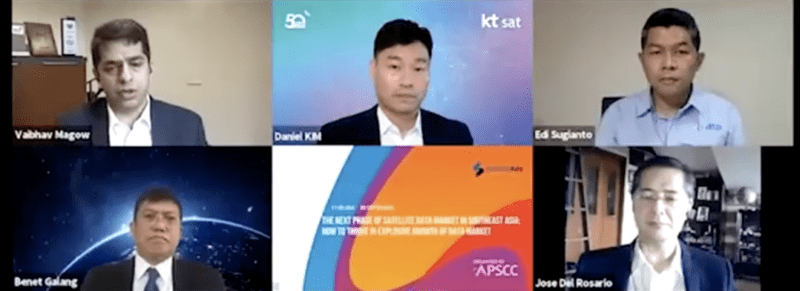Latest News

Panelists at ConnecTech Asia.
Asian satellite players see great potential in future in the satellite data market in Southeast Asia moving forward. During a virtual Satellite Asia panel discussion, part of ConnecTech Asia trade show, executives discussed challenges from the COVID-19 pandemic, future satellite markets in connectivity services, and working with future constellations in Low-Earth Orbit (LEO).
Daniel Kim, managing director of Oversea Business for KTSAT said the Korean satellite operator is experiencing difficulties with the COVID-19 pandemic, as customers and partners have had delays in completing projects and making payments. To deal with this, Kim said the operator is focusing on projects with concrete budgets like upgrading existing customers, and military and government orders.
In addition, Kim said South Korea is one of the most connected countries in the world, so the population doesn’t have the need for satellite connectivity that more geographically dispersed countries do. So KTSAT is transitioning to being a solution provider versus just a capacity provider. The operator is working on national satellite projects like a satellite-based augmentation system, and has strong business in maritime connectivity.
Kim said price, volume, flexibility, and differentiation are the key factors on the data market, especially satellite backhaul. As capacity prices decline, the cost of backhaul deployments will be more attractive to Mobile Network Operators (MNOs) to close their business case.
“The COVID-19 trends and continuous price declines may contribute to the creation of a new demand [from MNOs] for connectivity with a much larger volume,” Kim said.
Looking to the future, KTSAT is doing market analysis and in the early design phases for its next software-defined, High Throughput Satellite (HTS) over Southeast Asia, which the operator plans to serve specific customer groups based on concrete capacity demands. Kim said the satellite will be in Ka-band, Ku-band, and possibly Q-band, and V-band.
“Business viability will be guaranteed only when spacecraft and capacity are built and operate by concrete target segments, based on solid demands,” he said.
Edi Sugianto, COO of Indonesian company DTP (PT. Dwi Tunggal Putra), which provides internet, data centers, and a VSAT Network (Very Small Aperture Terminal), said data consumption is growing “exponentially” in Indonesia. The country’s geographic footprint of more than 17,000 islands make fiber connectivity very difficult, and satellite is better suited.
“But the most important thing is how we can deploy, that is my concern,” Sugianto said. “It’s not the bandwidth concern. Bandwidth is available, you have so many satellite operators flying on top of Indonesia. But the difficulty is in the deployment process. Some sites will take you two to three days to reach, it’s not as easy as a land country, it’s an archipelago.”
Sugianto said DTP empowers local skills and labor to deploy internet access to more sites quickly. Last year, the company deployed 130 teams to do a simultaneous installation for 155 sites in rural villages in one week.
“[We have a] huge potential market to enter. But due to the multi-diverse culture, multi-diverse people, various geographical profile under-developed infrastructure makes Indonesia one of the toughest markets to conquer,” Sugianto said. “But if you can choose the right local partner, apply local wisdom in every business strategy and understand the specific requirements for different regions in Indonesia, you will have one of the biggest markets in the world at your hand.”
Echoing Sugianto, Vaibhav Magow, the associate vice president who leads the Asia Pacific region for Hughes Network Systems, also sees demand for satellite broadband like never before in the Asia Pacific region, as demand for broadband grows, and terrestrial solutions cannot address all areas.
“The challenge really is how do we service this opportunity? As you have seen, there are many VHTS satellites, very large constellations coming about. How do we help satellite operators achieve a total system package, which helps them compete and bring in price points, as well as relevant service architectures for their customers to tap into this opportunity?” Magow asked.
Hughes believes that Low-Earth Satellites (LEO) will be part of that equation because of global coverage and lower latency, complementary with Geostationary (GEO) satellites, Magow said. Particularly, in the areas where Hughes is a service provider, Magow expects Hughes to use LEO capacity when it becomes available.
“Hughes is today looking at a scenario where you would have both GEO and LEO as complimentary. The solution on the ground would be that you have terminals which allow the customer to be able to choose the orbit,” he said. “So if there is an application which requires a lot of capacity, you would want that network to be getting bandwidth from a GEO satellite. If there are applications on that network, which need low latency, you probably would want to harness a LEO constellation.”
Get the latest Via Satellite news!
Subscribe Now